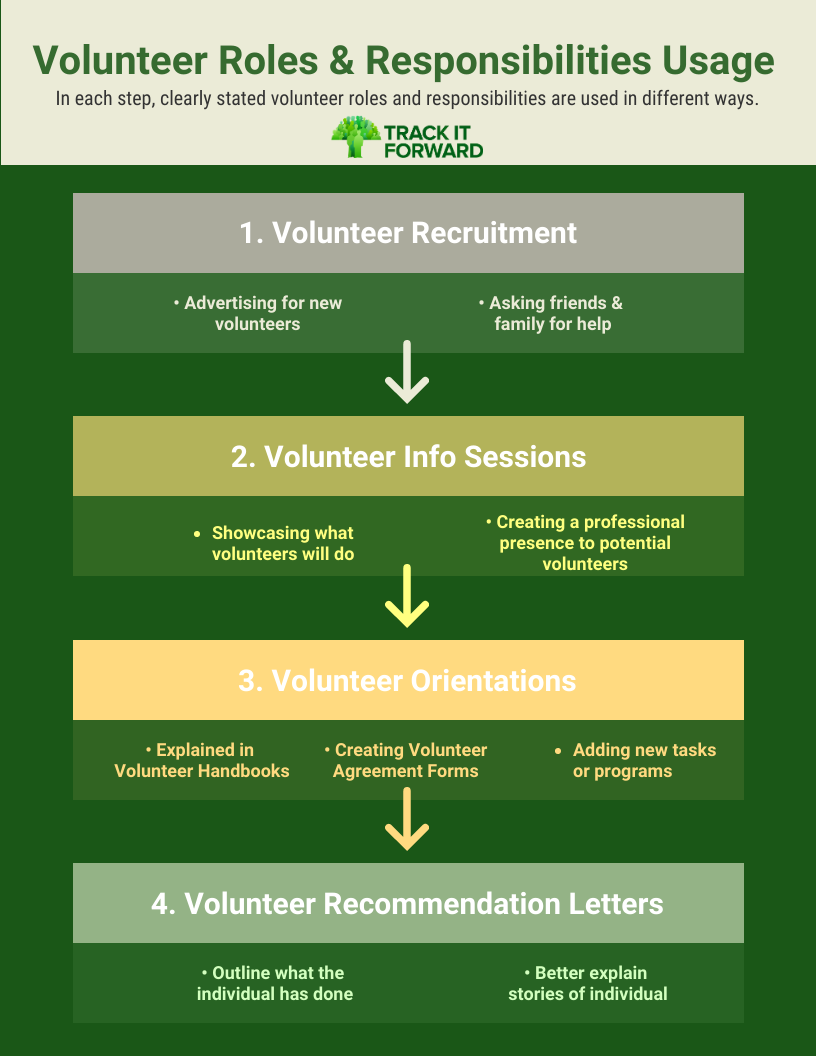When managing a volunteer program for a nonprofit organization, it is important to be very organized and create set roles and responsibilities for your volunteers. While some tasks may produce their own set of responsibilities, it is still important to have both general and specific roles and responsibilities for the volunteer.
These volunteer roles and responsibilities are essential to use in recruiting volunteers and retaining volunteers. If you are new to your role as a volunteer manager, or you just want to refresh your program, the absolute first thing you need to do is outline your volunteer’s roles and responsibilities.
Once this is officially outlined, you can move on with the rest of the important volunteer management tasks, and you will use these volunteer roles and responsibilities in the process!
Interested in downloading our full volunteer management handbook?
We have all the materials you may need to outline roles and responsibilities for your volunteers, and as a bonus, you get templates to volunteer agreement forms, volunteer handbook outlines, and recommendation letters templates!
Certain things you may need to use volunteer roles and responsibilities in could include volunteer recruitment tactics and volunteer orientation and info sessions. In volunteer orientations, you should have a volunteer handbook that all volunteers can see and follow to feel prepared to be a volunteer. Beyond that, you will need a volunteer agreement form, for all volunteers to sign to showcase their knowledge and understanding of what they need to do when volunteering for a nonprofit.
Even after the recruitment and onboarding process of new volunteers, it is important to have a clear outline of volunteer roles and responsibilities for things like a volunteer recommendation letter.
Some organizations even have a section on their webiste dedicated to volunteer roles, responsiblities, and rights of a volunteer. If your organization is more sensitive volunteering, it is important to go over volunteer rights as well.

We have created a volunteer manager handbook of all the things you may use your volunteer roles and responsibilities in. Volunteer agreement forms, volunteer handbooks, and recommendation letter outlines are all available for free, and in one location!
Why Volunteer Roles & Responsibilities Need to Be Outlined
Volunteer Roles & Responsibilities are important to be outlined because they are the basis of your volunteer program. They help clearly define what volunteers are meant to do and how they are meant to do it.
This helps define program tasks, programs, and events. When planning anything, you can consider how a volunteer may be able to help you based on their set volunteer roles and responsibilities.
In addition, clearly defined volunteer roles and responsibilities are needed to create a successful volunteer advertisement, volunteer training sessions, and volunteers in general!
One of the hardest parts of running a volunteer program is retaining new volunteers. After a volunteer signs up to be a volunteer, they need strictly defined roles and responsibilities to help them understand if they want to continue. Most people, when given enough information and the ability to predict their volunteer experience, will be happy to stay and continue volunteering!
Clearly defined Volunteer Roles and Responsibilities can make a small or large impact in the following areas of volunteer management.
- Volunteer recruitment
- Creating Volunteer Handbooks and Agreement Forms
- Volunteer retainment
- Branding and Organization of Volunteer Programs
- Engaging volunteers
- Giving Volunteers Leadership Opportunities
- Writing Volunteer Recommendation Letters
For advice on what to include in your volunteer roles and responsibilities, download our full volunteer management handbook! You will get access to a roles and responsibilities checklist, as well as other bonus materials!
What To Keep In Mind When Creating Roles & Responsibilities for Volunteers
It is important to keep in mind that people usually volunteer for a social aspect or to feel like they are making a difference. So, volunteering should be a light-hearted and enjoyable experience for the volunteer.
Even though it is your job to run a volunteer program, a volunteer is not an employee and should not be treated as such in terms of punishment, grading, and accountability. Keep in mind that volunteers want to think of volunteering as an enjoyable experience, not another job.
Volunteer Roles and Responsibilities may not always be fun to write or read, but they give volunteers the perfect picture of what their volunteering experience will look like, and how their work will make a difference and help the organization.
Volunteer Roles & Responsibilities Usually Include
- Keeping internal information confidential
- Respecting staff members
- Accepting and following rules and guidelines of the volunteer role
- Completing duties promptly
- Logging volunteer hours
- Being willing to learn and participate in meeting and training programs
- Communicating when not able to attend a shift
- Assisting with organization-sponsored event supervision
- Logging more hours than required
- Donating funds and in-kind donations
Volunteer Roles & Responsibilities Do Not Include
- Full-time, consistent schedule
- Compensation
- A legal binding contract
- Punishment for lack of attendance
Where to Put Your Volunteer Roles & Responsibilities
Volunteer Roles and Responsibilities do not necessarily need to be shared with your volunteers directly, rather they will be located in other materials that your volunteer will receive. Volunteer Roles & Responsibilities can be an updated document that you keep to always refresh and use for new volunteers.
- Volunteer Roles and Responsibilities should be briefly explained in any volunteer advertisement or in the process of recruiting volunteers.
- Volunteer Roles and Responsibilities should be in detail in volunteer handbooks. These should be given to volunteers in volunteer orientation or info sessions.
- Also in a Volunteer Orientation, your volunteers should be given a volunteer agreement form. This is another way to outline any sort of guidelines or strict rules your organization wants to enforce and to gain your volunteer’s signature.
- You can continue to update your volunteer roles and responsibilities as you add new tasks or rearrange programs. These can always be brought up again in meetings as new volunteer initiatives are introduced. Or as a refresher to existing volunteers!
- Lastly, if a volunteer leaves or would like a recommendation letter for a job, you can have their roles and responsibilities clearly defined to place in the letter!
If you would like to read more about each of these above, please continue reading next in the series below!
Frequently Asked Questions
1. Are volunteer roles and responsibilities the same as volunteer agreement forms?
No, volunteer agreement forms are specific documents that volunteers sign to say they have read any terms & conditions with volunteering and agree to do what is listed. But, volunteer roles & responsibilities can be included in a volunteer agreement form.
2. Do I need to outline all of the volunteer responsibilities for every program?
It is up to you and your organization how you decide to relay information about different volunteer programs or committees to different volunteers. Be sure that a volunteer has all the information they need for volunteering in any program possible.
 Last updated by
Last updated by